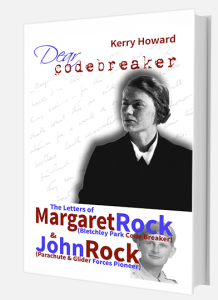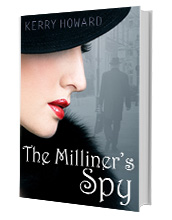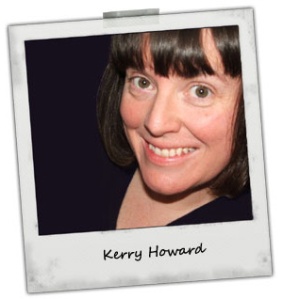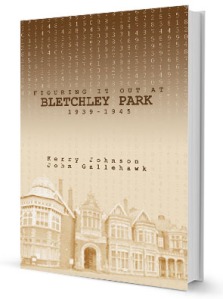An Interview with Researcher and Author, Kerry Howard
By J. Lynn Stapleton
In August of 2013, I had the opportunity to visit Bletchley Park. There was so much to see and take in, and yet there was still much to uncover as the park’s restoration continues. Many of the huts which held the Bombe machines were still in poor condition. The Park in itself had been under threat of demolishment more than once, which would have been a great tragedy as it is one of the most historic points in British history, and indeed world history, as the site where the German Enigma code was broken thus ending the War as much as two years earlier and saving millions of lives.
Bletchley Park, also referred to as Station X, was home to the Government Code and Cypher School – the precursor to Britain’s communications intelligence service – Government Communications Headquarters (GCHQ), and the home place of modern computing. The war-time cyphering work decoding Enigma, Lorenz and the Sturgeon at Bletchley Park remained covered by the Official Secrets Act until the 1980s; officially Station X did not exist, and the employees were unable to inform anyone or speak of their work, lest it get into the hands of the wrong person(s). The mystery about that period of history at Bletchley remains so intriguing, as it is part of our not-so-distant past.
Recently, more attention has been paid to Bletchley Park, in part due to shows like ITV’s “The Bletchley Circle” and the film, “The Imitation Game”, a fictionalised bio-pic of Alan Turing during his time at Bletchley Park and his creation of the Turing Bombe Machine, which was instrumental in speeding up the deciphering time to decode the German military messages.
There was so much more going on at Bletchley Park, and I recently had the opportunity to speak with Kerry Howard, an author and researcher about her work at Bletchley Park Research, which provided me with further insight into the goings-on during World War II, and the life of some of the individuals who worked there.
********
JLS: On your website, you wrote that it was discovering Robert Harris’s 1995 book Enigma that sparked your interest in the codebreakers at Bletchley Park, to the point where you wanted to become part of the project of cataloguing and archiving photographs and documents related to the Park’s wartime history. What was it about the materials you were working with that really excited you and made you want to take your research even further?
KH: Every other Sunday for a period of about 12 months, I travelled the 80 miles to Bletchley Park eager sit in the Archive, often alone and do my bit towards preserving Bletchley Park’s history. Piled high with cupboards full of declassified documents copied from The National Archives, and boxes of memorabilia donated by Bletchley Park veterans, the cluttered archive had the musty smell of the past. At the time all resources were needed at restoration, so the archive had the feel of ‘make do and mend.’ It was wonderful. In the cold silence I could almost hear the sound of people behind the glass panel of the door at the end of the corridor. My sense of fascination was somewhat indulged by peeking at the photographs and documents I had the privilege of cataloguing and felt excited that there were so many stories yet to be told. What I did was really very minor compared to the work carried out by the archive volunteers during the week. Those early archive pioneers should be saluted for laying the groundwork the Bletchley Archive today. It is full of remarkable information that I have long hoped would be more available to the public. I think that time in the archive is the start of my love for the untold stories of Bletchley Park and the small details. I’m much more excited by the journals, the letters, index cards and even the little envelopes used for the wages than the formidable Enigma machine. It will continue to survive in its wooden box and fascinating the world with its complex interior workings, but the day to day memories of the people who worked at Bletchley Park and small threads of their past are easily forgotten and will all too soon pass out of living memory.
JLS: What was it like for you the first time you stepped through the gates of Bletchley Park? And how has it been as you see how the Park has continued to expand through its restoration process?
KH: I felt the enormous spirit of the volunteers who worked relentlessly to save Bletchley Park. They welcomed me, showed me around and patiently helped me learn about its past. I distinctly remember that an Enigma machine used to be out and could be freely used by visitors, but I can’t remember where it was – so much has changed and been moved around in the last 14 years. There have been times that I have thought that too much restoration would mean no more musty smells and imaginings of Bletchley ghosts. However, the sympathetic restorations, such as in Hut 3 and Hut 6 mean we no longer have to imagine what it was like – they are set out to evoke what they would have been like and modern technology cleverly hidden in filing cabinets projects the Bletchley ‘ghosts’ on the wall for all to see. I also love that more of the small details – the index cards, the journals, the wage packets – are now on display in the renovated Block C.

JLS: In Dear Codebreaker: The Letters of Margaret Rock and John Rock, you mentioned that finding the letters and photographs from Margaret’s nephew was a game changer for your research. The letters were a fascinating read in seeing their daily lives as children growing up with a father who’d been killed in duty, and then during their time during World War II. In what way(s) were they (the letters and photographs) a game changer for you?
KH: If only I could bottle up the experience of that first weekend I spent going through Margaret’s papers! Until that point Margaret Rock was simply a name mentioned in some of the books about Bletchley Park. Always spoken of with high regard but no information about her as a person. That’s the exact thing that gets my research fingers tingling. To then be able to walk through her life through the words written by Margaret, her mother and particularly her brother John was spellbinding. For the first time we could see Margaret’s photograph, understand her background and just how Bletchley Park impacted her life. She was an amazing woman and a truly unsung hero of Bletchley Park. The biggest surprise was the intense emotional response I had for her brother. Most of the letters are written by him and the family’s lives are mostly seen through his eyes. Even though I knew he had died in 1942, I grieved when his letters stopped and the next item was his obituary. So during that weekend I found a Margaret, but was unexpectedly moved by John.
You can visit my website Bletchley Park Research and download a free profile on Margaret Rock as well as a copy of an original letter she wrote in September 1940, which describes her attempt to return to Bletchley Park during a London Blitz bombing raid.
JLS: You’ve also remarked on the website about revising an early book you’d written with John Gallehawk, called Figuring It Out At Bletchley Park, 1939-1945. What can you say about the research behind it, and the revision process?
KH: Figuring It Out at Bletchley Park, 1939 – 1945 is the child born out of the time in the Bletchley Park archive. While there I worked with John Gallehawk who is one of those early archive pioneers. I have been fortunate to count him as a friend and his knowledge of Bletchley is exceptional. I stopped travelling to Bletchley after a motorway crash but I began helping John to convert the official numerical data held at The National Archives into a useable resource for others. The weekly returns, which took over a year to collate, chart the number of civilian and service men and women, their sections, transport, billets and even their food through the war offers a unique insight into the growth of the codebreaking operation at Bletchley Park. It’s a book where the numbers do the talking.
We’ve been adding another 50 plus tables covering merchant shipping losses, U-boat decrypts and Bomber Command operations. The work at Bletchley Park had a profound effect on reducing these losses. The text of the book is also undergoing an overhaul so it goes beyond explaining the data and provides more background information. All I can say is that the extended version will be available in 2015.

JLS: Of the ten thousand workers at Bletchley Park, about seventy-five percent of those were women, however, very little is known about many of them, in their work as WRNS (Women’s Royal Naval Service), generally referred to as Wrens, working on the Bombe machines and as cryptographers, deciphering the Enigma codes. In your new book, Women Codebreakers at Bletchley Park: The Story of Margaret Rock, Mavis Lever and Joan Clarke, (available for preorder here), you examine the lives of these women in their roles at Bletchley. I notice you also added Ruth Briggs on your website for further research. What was it about these women that piqued your interest?
KH: The number of women at Bletchley Park peaked in the last week of January 1945 with 6,769 women compared to 2,225 men. Of these women, 2,660 were civilians and 4,109 were in the armed services. This compared to 738 civilian men and 1,487 men.
Margaret Rock, Mavis Lever and Joan Clarke were all part of the civilian numbers and were first employed by the Foreign Office for clerical work. Mavis and Joan were recruited straight out of University in 1940 but Margaret was much older at 36 when she arrived, also in 1940. Margaret and Joan were mathematicians and Mavis a German Linguist. Margaret also spoke very good German yet Joan always enjoyed saying ‘Grade Linguist languages none’. The Bletchley bosses wanted educated women but never expected, or planned for the fact that they could be as capable at cryptanalysis as their male peers. Luckily these women found their way into nurturing environments with male section heads who saw their potential and let them fly. Yet, I feel that even now they have never been given due attention in the history books. It’s a great honour to be able to bring their stories into the public domain. Their stories not only sheds light on Bletchley Park but also on the changing role of women during the war and how the discovery and exploration of their potential changed their lives forever.

JLS: What other projects are you working on? Interested in pursuing further?
KH: I’ve been working on a historical novel The Milliner’s Spy since last year. The final edits have been on hold while I finished Women Codebreakers. You can find out more about this World War 2 novel set in a hat shop at www.milliners-spy.com and download a free chapter. I have also been researching the story behind the first occupation at Bletchley Park in 1938. Captain Ridley’s Shooting Party has been a long term project that I will hopefully (and finally) complete in 2015.
You can find me at www.bletchleyparkresearch.co.uk
On Twitter as @CaptainRidley
On Facebook as BletchleyParkResearch





Reblogged this on laramaynard.
Lynn, reblogged this! I do The Bletchley Circle Watchers on facebook, and replied via comment to your post there where you notified of this blog post. I met Kerry online through an interest in the TBC series and BPark heritage. Will also share your blog post @ https://www.facebook.com/TheBletchleyCircleWatchers later in Dec.
Cheers and Seasons Greetings! -LM of #TBCW
Thanks for the reblog. Nice to get this out there more!
Reblogged this on Dr Sue Black and commented:
Fabulous blogpost interview with Kerry Howard @captainridley on Twitter about the female codebreakers at Bletchley Park: Mavis Batey, Joan Clarke and Margaret Rock 😃